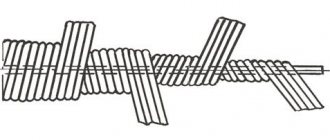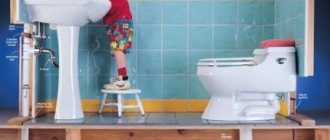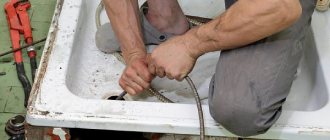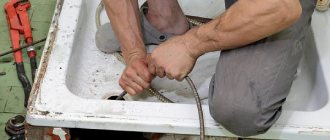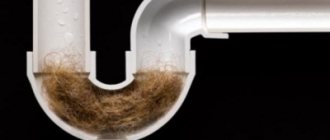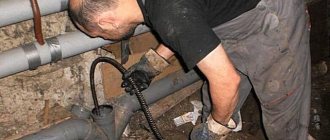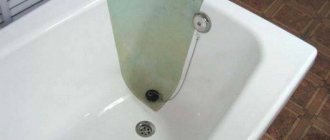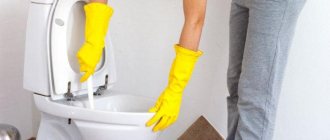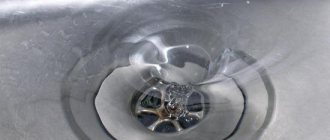A clogged toilet is a common and annoying problem that requires quick fix.
You can unclog a toilet using mechanical and chemical methods. In complex cases that cannot be corrected on your own, you will need the help of a plumber.
In this article we will tell you how to quickly clear a clogged toilet at home.
Reasons for the problem
A clogged toilet needs to be cleaned immediately. The problem is often caused by the following circumstances:
- entry into the drain of foreign objects that interfere with the passage (rags, personal hygiene items, etc.);
- defects in the toilet itself;
- violations in the sewer system;
- improper installation of the structure;
- deposits on the inside of pipes.
Before you start cleaning, you need to determine whether the problem is local, affecting only the toilet, or whether the entire drain system is clogged. To do this, open the taps in the bathroom and sinks and watch how quickly the water drains.
If the water drains quickly, then the problem is only related to the toilet, and you can solve it yourself. Otherwise, professional help will be needed. Violation of the rules for using plumbing is the main cause of blockages.
Localization of the blockage
It is important to determine the location of the plug. For this purpose, check how the water leaves the washbasin or bathtub. If everything is in order, then the blockage has formed in the toilet siphon, outlet or cuff connecting it to the sewer pipe. If the water from the bathtub also does not flow well, the blockage is localized somewhere in the common pipe.
If the drains flow out of the toilet like a fountain, then the riser is clogged. Residents on the upper floors should be asked not to use the sewer and immediately call plumbers.
How to eliminate mechanically?
When choosing a cleaning method, you must take into account that the effectiveness of removing blockages from the drain depends on the following factors:
- Why is the toilet clogged?
- Old age of the problem.
If the plug is the result of a foreign object, then you must first remove the water from the bottom of the toilet. For this purpose, you can use rags and sponges.
If the blockage happened recently, you can try to remove the stuck object with a gloved hand. In cases where this fails, they proceed to mechanical cleaning or use a chemical method.
plunger
A plunger is one of the simplest and therefore popular means of removing blockages in pipes. There are a lot of varieties and modifications of this instrument .
Ordinary
If the blockage is not complete and the water gradually drains away, it just happens slowly, even the most ordinary plunger of a familiar shape will help solve the problem.
When purchasing, you must take into account the toilet model, as not all types of plungers may be suitable. The technology of work is to make forward movements, pressing on the handle and sharply lifting it up.
The simplest plunger is recommended to be used only in untreated cases , since in case of severe blockage it will not be effective.
Pneumatic
It is much more convenient and effective to use a pneumatic plunger for problems with the toilet. Outwardly, it looks like a hand pump. This device is not only very effective, but also universal - it is suitable for almost any toilet model.
Advantages of pneumatic valves:
- compactness;
- ergonomic shape;
- set of nozzles included;
- ease of use;
- versatility.
Aeration
Aeration models are designed to regulate air in the system. This helps prevent debris from getting stuck in the toilet and drain pipes.
Cables
For complex blockages, it is more effective than a plunger to use a special metal (less often plastic) cable designed for cleaning. It has a fairly simple device and does not require special skills to use. There is a special tip at the end of the device.
Metal cables have proven to be the most reliable. This design will be more efficient and last longer.
Procedure:
Free up space around the toilet.- Wear personal protective equipment.
- Prepare a bag for placing the removed waste in it.
- Insert the cable from the end into the toilet.
- Rotate the cable using the handle so as to break through the blockage.
- Remove the cable. There may be debris at the end that needs to be removed and placed in a bag.
- Wash away any remaining dirt with a stream of water.
After use, the cable should be cleaned and dried. It is better to store it rolled up.
Plastic bottle
In cases where there is neither a cable nor a plunger available, you can use a regular plastic mineral water bottle with a volume of 1.5, 2 or 2.5 liters.
Application procedure:
- The bottom is cut off from an empty bottle with a knife, but the cap is not screwed off;
- lower the bottle with the cut part down;
- turn the bottle without removing it so that a vacuum is formed;
- press the top edge of the bottle with a sharp movement so as to push the blockage further, pushing it into the riser;
- remove the bottle;
- if necessary, repeat the processing.
You can watch the process of clearing a blockage without a plunger in the video:
Tools
As you know, he who is forewarned is forearmed. However, information about the causes of blockages is not the only weapon we will have to use. To effectively deal with blockages, you need a small set of tools.
What tool is useful to have at home in case of blockages?
- Plunger. There is not the slightest need to spend money on a professional tool with a piston and pressure gauge: a regular rubber cap on a plastic or wooden handle for home use is no worse. A reasonable price for a plunger is no more than 200 rubles;
Cheap and cheerful.
- Plumbing cable. Its simplest version is a piece of steel sling with a handle made of a steel tube bent in the shape of the letter “Z”. Factory-made products with a plastic shell rotating relative to the handle and a cable made from a spring wound around a steel core are no different from it in practical terms.
A good tool with a reasonable price.
Cables with a drum are convenient because they can be used alone, without an assistant. However, such a product costs several times more than a regular plumbing cable. As a rule, they are bought by professionals: the device can significantly save your time only when clearing a large number of blockages during the day.
The product in the photo is intended for professionals. With rare home use, such a tool will not pay for itself.
If your nearest hardware stores don’t have the tools I listed, it doesn’t matter. As you will see later, you can often make do with improvised items instead.
How to remove using folk remedies?
If you don’t have special household chemicals on hand, you can try to clear the clog with home remedies.
The easiest option is to pour in a bucket of hot, but not boiling, water. Let it stand. This option will help if the problem arose due to food debris or when wood cat litter gets into the toilet bowl.
Soda
To remove a blockage caused by pouring fatty foods into the toilet, you can use a soda solution. To do this, dilute ½ pack of soda in 2-3 liters of water and pour it into the toilet .
After 3 hours, the blockage should be cleared, since the soda will interact with fatty deposits. For serious blockages and those whose cause is unknown, this method is not suitable due to its poor effectiveness.
Soda and vinegar
To clean, you must perform the following steps:
- Pour ½ pack of soda into the toilet.
- Pour in a bottle of vinegar.
- Close the drain hole.
- Leave for 2 hours to act.
- Pour in hot water.
- Wait an hour.
The method is quite effective if the cause of the blockage is organic matter or buildup in the pipes.
Soda and salt
Procedure:
- pour 1 cup of soda into a container;
- add 1 cup salt;
- mix;
- fall asleep in the toilet;
- after 5 minutes, pour 1 cup of boiling water in a thin stream;
- leave for several hours to act.
It is recommended to use this method at night.
How to Clear a Toilet Paper Clog Using Baking Soda
You can remove operational blockages using regular baking soda, which in most cases is available to every housewife.
- Dissolve half a pack of soda in warm water.
- Pour into the toilet drain hole.
- After 2 hours, rinse the toilet with water.
There is a more effective way using baking soda. Since the soda solution is alkaline, if you heat it in a frying pan, it will become more active and will be better able to cope with the blockage. For this you will need:
- 150 g of baking soda (about 5 heaped tablespoons);
- 200 ml water;
- pan.
Step-by-step instruction:
- Pour baking soda into a frying pan and heat over low heat for 15 minutes, stirring continuously. By the end of the process, the release of carbon dioxide should stop, and the soda will become more flowable.
- Remove the pan from the heat and let cool for 10 minutes. This is a prerequisite necessary to prevent burns when the substance is combined with water.
- Pour the resulting powder into a working container and add 200 ml of water to it. Mix well. The sodium carbonate should either completely dissolve in the water or leave a small residue.
- Pour the resulting light brown solution into the toilet drain hole.
- After 2 hours, rinse the toilet with plenty of water.
Baking soda is an effective toilet cleaner
How to quickly remove with special chemicals?
In stores you can find a large number of pipe cleaning and sewer maintenance products. The drugs are available in various forms, differing in price , exposure time and composition.
Most household chemicals used to remove blockages have an aggressive composition, so they should be used strictly according to the instructions and in compliance with safety precautions.
Sanox gel Pure stock
The drug is intended for pipes - eliminates odors and blockages. The composition contains surfactants. Suitable for use when organizing sewerage with plastic and cast iron pipes.
Advantages of the product:
- low cost;
- ease of use;
- efficiency;
- price;
- suitable as a means of prevention.
Minuses:
- it takes time to achieve results;
- may not help with serious blockages.
The price, depending on the point of sale, can be up to 100 rubles. Read reviews here and here.
Mr.Muscle active gel
The product is available in liquid form, completely ready for use. For mild blockages, the exposure time is literally a few minutes due to the high concentration of active components. If the water stopper is caked and hardened, Mr. Muscle may need several hours to work.
Advantages:
- high efficiency;
- active composition;
- fast action;
- ease of use.
Minuses:
- caustic composition;
- price;
- For severe blockages it will take several hours.
Price – about 300 rubles for a 0.5 liter bottle. In the same series of products, the manufacturer produces not only gel, but also sachets with powder for removing blockages. Read reviews here and here.
Deboucher
The product is designed to clear sewer blockages. It has a thick form, actively interacts with substances that impede the passage of water, and eliminates odors.
Advantages:
- fast action;
- efficiency;
- safety for all types of pipes.
Cons: high consumption. The cost is about 200 rubles on average. Read reviews here.
Preventive measures
Prevention of occurrence is the following list of measures:
- Installation of new equipment must be carried out in accordance with all rules.
- It is unacceptable to throw garbage, cat litter, leftover fatty food, etc. into the toilet.
- Regular care of your plumbing fixtures and periodic cleaning will help reduce the accumulation of various deposits.
- Flushing the tank after using the toilet will allow the pipes to be flushed and will prevent sediment from accumulating.
- If it is necessary to replace pipes, the new ones must be identical in size to the old ones. Plastic is preferable to metal, as it has a smoother surface that is less prone to the formation of deposits and blockages.
- When carrying out repairs in a toilet room, the toilet lid must be lowered. This will prevent construction debris from accidentally getting inside.
- At least once a week, the toilet should be cleaned using household chemicals to prevent the formation of sediment and deposits.
Preventing clogging
In order to prevent the toilet from clogging, or to delay such a problem, it is necessary to use it only for its intended purpose and minimize the entry of foreign objects into it.
- In the event that something gets into your toilet, it is best to remove everything unnecessary from it immediately.
- Many people prefer to pour dirty water into the toilet after washing the floors; this is absolutely not worth doing, or it is recommended to use special filters that prevent the penetration of debris.
- If there are small children living in the house , then it is best to carefully ensure that they do not throw their toys into the toilet, and also try to explain to the child in as much detail as possible why this is not required. From an early age, it is necessary to teach a child how to use the toilet correctly and for its intended purpose.
- Another condition for preventing a clogged toilet is that you should never pour greasy water into it, as fat accumulates on the bends and over time forms a clog that will be very difficult to remove.
- Some housewives make one of the most serious mistakes, leading to irreparable consequences. They throw leftover food down the toilet. This applies not only to solid waste, but also to liquid treats.
- If renovations are planned in a house or apartment , then in order to prevent construction debris from entering, it is best to carefully cover the toilet. This will also prevent dust from getting inside.
- In the case of preventing blockages in an apartment building, all issues must be resolved without fail and prevention must be systematically carried out, which must be monitored not only by the residents, but also by the management company.
Important! It is recommended to systematically use specialized products to prevent blockages. They are sold in all household stores. When purchasing such a product, you should check that “prevention” is written on the label. This product must be used only strictly according to the attached instructions.
In addition to professional means for preventing blockages in the toilet, more accessible and inexpensive options are used, the components are available to almost any housewife. For example, soda, which is diluted with hot water and poured into the toilet approximately once every two weeks.
The cause of a blockage is not always grease or the ingress of foreign objects, since sewer pipes wear out sooner or later, and the resulting rust causes the blockage. In this case, only a complete replacement of the sewer will help, otherwise eliminating the blockage will be repeated systematically.
Despite the fact that, after reading this article, everyone became familiar with methods for removing any blockage, you should not let your toilet get to this point. After all, it is much easier to prevent than to eliminate, so save your strength and nerves by using the toilet for its intended purpose, as well as taking the necessary preventive measures.
Recommendations
Recommendations from plumbers will help you cope with the cleaning task efficiently and without unpleasant consequences:
- If you discover that the toilet is clogged, you should not try to immediately drain the water from the tank. It must be taken into account that the volume of water contained in it is several liters. If it drains into the bowl, some of it may even splash out onto the floor.
- If any object accidentally falls into the toilet, for example, a toy, keys, etc., then you should not press the flush, as this may cause a blockage. In this case, you need to put on rubber gloves and take out the item.
- All pipe cleaning work should be done with rubber gloves, even when traditional methods of clearing blockages are used.
- It is more convenient for two people to break through a blockage using a cable, when one person rotates using a handle, and the other directs the cable itself to the place of the blockage.
If you are interested in how to clear a clog in a pipe, sink or toilet, take a look at this section.
When do you need a plumber
If you cannot break through the toilet using available means, all methods and means of clearing blockages have not brought results, you need to think about calling specialists. They can inspect the plumbing and determine whether it is necessary to try to restore normal functioning or install new equipment.
This is especially true when the plumbing equipment is old, the drain hole in it is overgrown with a layer of urinary stone by about 15 mm. The plumber will quickly remove a massive dirt plug or remove the stuck object.
